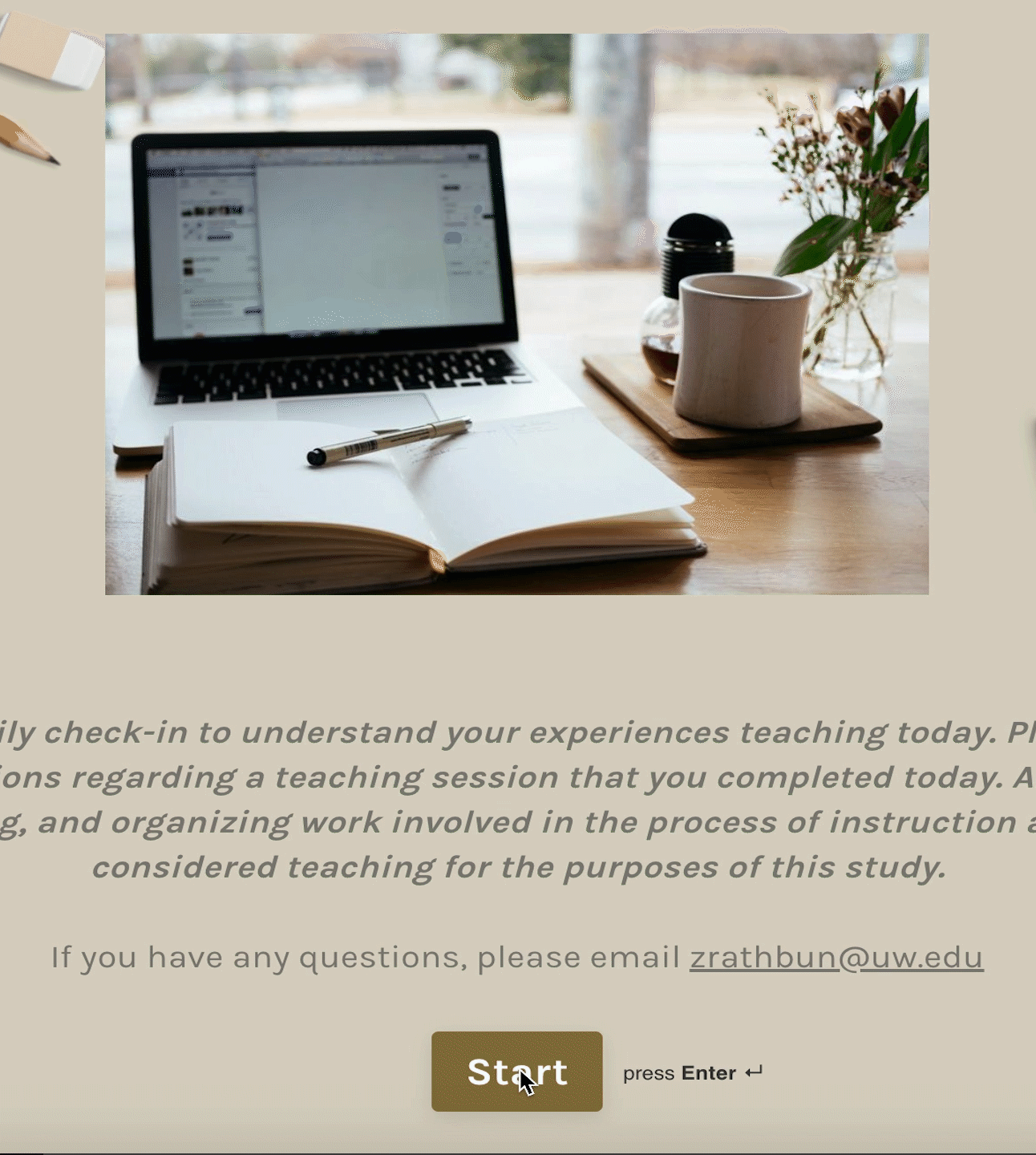
Remote Teaching During COVID-19
Overview
A study to investigate the challenges, adaptation and successes of K-8 teachers during the global COVID-19 pandemic.
Duration
11 Weeks
Team
Kayla Park
Vera Liao
Methods
Secondary Research
Diary Study
Semi-structured Interview
Deliverables
Study Plan
Study Guide and Test Kit
Research Report
Research Presentation
The Challenge
The current COVID-19 pandemic has shifted many full-time employees to work remotely, however, few shifts seem more drastic than the shift teachers have experienced in moving to remote education. Teachers support students' learning, development, and socialization in the in-person teaching environment. My team started our research with the assumption that these processes can not easily be translated to remote work. We were interested, therefore, in the shifts teachers have made, the tools they use, and the challenges they face in the current remote teaching climate.
Research Questions
What tools, processes, and workarounds are teachers using to offer education in these circumstances? From their perspective, what has worked and what hasn’t worked?
What are teachers’ key challenges and successes in their remote teaching experience thus far?
PHASE I
Diary Study
The goal of our diary study was to understand the daily experiences of teachers over one week of teaching. We asked them to respond to a short daily questionnaire about the activities and tools used in a given day. We also asked them to explain any particularly challenging or successful moments in their daily teaching routine.
Participants
Analysis
Based on 12 diary entries, we used Miro to record the tools used for teaching by each participant. By analyzing participant sentiment (motivations and pain points), user behavior and usage patterns, we looked for common themes among the responses and grouped the relevant quotes together using affinity diagramming.
Results
1. Technical difficulty.
Predictably, teachers faced technical difficulties which took a toll on the teaching and grading workflow. These experiences are very frustrating and embarrassing for teachers.
2. Lack of student engagement.
In the remote education setting, teachers reported that student engagement had decreased. Many students consistently did not turn in work on time or at all. This was challenging for teachers who no longer have the face-to-face engagement with their students to encourage them to do their work.
3. Individual Learning.
It was difficult for the participants to gauge where individual students are at in their learning experience in a remote setting. It is difficult to check on all students, and some tend to fall into the background.
4. Small, Meaningful moments.
Meaningful online interactions or moments of helping a small number of students became sources of motivation for the participants. Even these small successes were reported by participants within the chaos and challenges they faced.
PHASE II
Semi-Structured Interview
After Phase 1, we wanted to move into semi-structured interviews to get richer stories of teacher’s personal experiences. Based on our phase 1 findings, we decided hone in on (1) the adaptation period, (2) student engagement, (3) support from schools and other teachers
Results
Student Engagement
Student engagement is a problem because students are still in the process of becoming independent learners--they do not do well with the lack of structure and interpersonal attention as compared to traditional school.
“Um, I think the biggest challenge is just to get the students engaged with the work, because I have some students who they're gonna do whatever I assign regardless, like they're just gonna do it. Um, but that's only really like, maybe a third of my class.” -P3
“Getting maybe a third of their students doing consistent work… And a lot of them really struggle with things like doing it by themselves.” -P4
“And a lot of kids in that class have just disappeared. I don't, I don't hear from them ever. breaks my heart. They're good. They're hard working students left. It's like, like it ruins it. It ruined it for them. They don't even want to try. It cheapens it to try. ” -P6
2. Shifting Goals
Understanding the difficulty of remote teaching, teachers have shifted the focus from academic achievement to a time for social gathering, small learning steps and engaging activities.
“I was definitely prioritizing their relationships and connections with each other. More than academic content, cuz me and a lot of my colleagues, we both agree that, you know, this time is kind of gone. You know, like, it's just, it's, it's just, they're not going to learn as effectively as if they were at school.” -P3
“Making sure the parent knows like, what if they just do some work, click, that's great. Like, we don't expect them to be able to do all of the seventh grade general education science. But like encouraging them to continue the practice of learning and writing and reading.” -P4
3. Teacher Support for Trial and error
Because teachers have had to figure everything out as they go, seeking support, feedback and guidance from teachers in the same grade and subject of them reduces the burden of constant trial and error.
“I've reached out to the seventh grade science and social studies teachers just to say, hey, this is where my students are at, like, if I'm supporting them, what should I be concentrating on with them? Um, I've gotten some responses and then the reading and writing the teachers and I talk often just about what works, what doesn't like we use each other's videos. I think one teacher came up with a whole spreadsheet he made so we could track students' engagement, and I think he's going to be coming up with more things like that to help collaboration.” -P4
“I had pretty strong communication With my grade level teams, so at my school, fourth and fifth grade work together, it's not just fifth grade. And we would gather weekly to talk about things that were working things that weren't working. Just kind of ideas on how to organize your, your Google Classroom.” -P3



